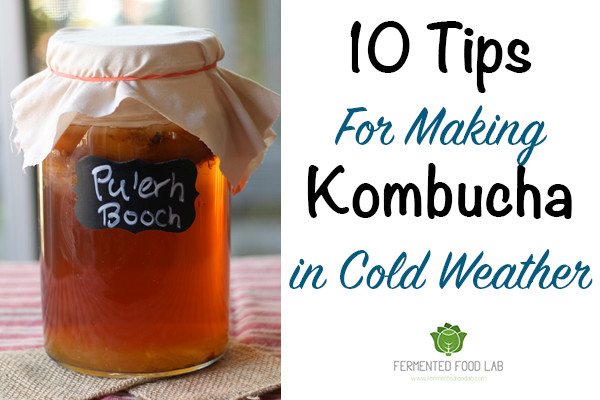Is your kombucha taking longer to ferment than usual? Are you having a hard time getting it to ferment at all? It’s totally normal for kombucha, water kefir and other ferments to take much longer to ferment when the weather gets cold.
Kombucha loves warm weather. Ideal temperature for brewing kombucha is 75-85°F . If you brewed it over the warmer months, you know that a batch can be ready in 7- 10 days, leaving you with a steady supply of booch all summer long. During the colder months my kitchen can drop to an average of 60°F, making it take much longer to brew. Maybe a month or more.
10 Tips For Making Kombucha In Cold Weather
If your kitchen is cooler and it seems to be taking forever to brew your kombucha, try these tips.
- Move the kombucha to a warmer spot in the house. Any room that stays warmer than your kitchen, such as a bedroom or living room may work.
- Store it above the refrigerator or on a high shelf where the air temperature tends to be warmer.
- Wrap the kombucha in a towel for insulation.
- Place it in the oven with just the light on. The oven light can emit just enough heat to keep the kombucha warm. Don’t forget it’s in there when you use the oven.
- Use a heating pad to keep it warm, but make sure it has a thermostat so it can shut off when the temperature gets too high.
- Seedling mat – If you garden, you may already have one of these around. It can bring the ambient temperature up 10-20 degrees. You can purchase a seedling mat here.
- Kombucha heating strip by Kombucha Kamp – These were made specifically for brewing kombucha in cold weather and worth the investment. You can also heat multiple vessels with one.
- A fermentation heating belt made to brew beer can also work for Kombucha.
- Place the kombucha on top of a plate on an appliance that’s always running, like a DVR.
- Place it near a lamp, but not directly under a lamp. Sometimes that’s enough to keep it warm.
I highly recommend placing an adhesive thermometer strip on your kombucha vessel to monitor the temperature.
Do you have tips for making kombucha in cold weather? Please share in the comments below.
Happy Fermenting!
Danielle

In the UK I leave my water kefir in the airing cupboard where the hot water tank is. I also leave avocados there. It’s the only place where it really gets bubbling! I also leave my kefir soda (2nd ferment) there for a few days to get it bubbling before the fridge – just got to remember to ‘burp’ it as I had one explosion which wasn’t pleasant!
Thank you for sharing Stuart!
I do that with proving bread dough, too – perfect place :)
How can you tell when your first ferment is done and your ready to do the seond? Mine has been brewing for 7 days.tea is lightening up, it has a slight vinergary smell, but when I taste it is is a very mild barely sweet tea. I have read that when adding fruit for a second ferment that it was best to start slightly sweet. My house has been running aboyt 60 degrees most days with a few close to 70
Sounds like it’s ready. It should taste slightly sweet or if you like it more sour, let it ferment longer. You should add sugar or juice when you second ferment it to reactivate the bacteria and make it bubbly.
I tasted some I have in the cabinet doing their second ferment. This is day 4 for that. They tasted very mild, ittle weak, and almost no carbonation. I added 1/4 fresh cherries that were cut in half and a tsp of vanilla flavoring. I drank some GT Synergy today it has a much stronger taste. I started with 10 tea bags. Some green, some black herbal. and 1 c sugar to a gallon.